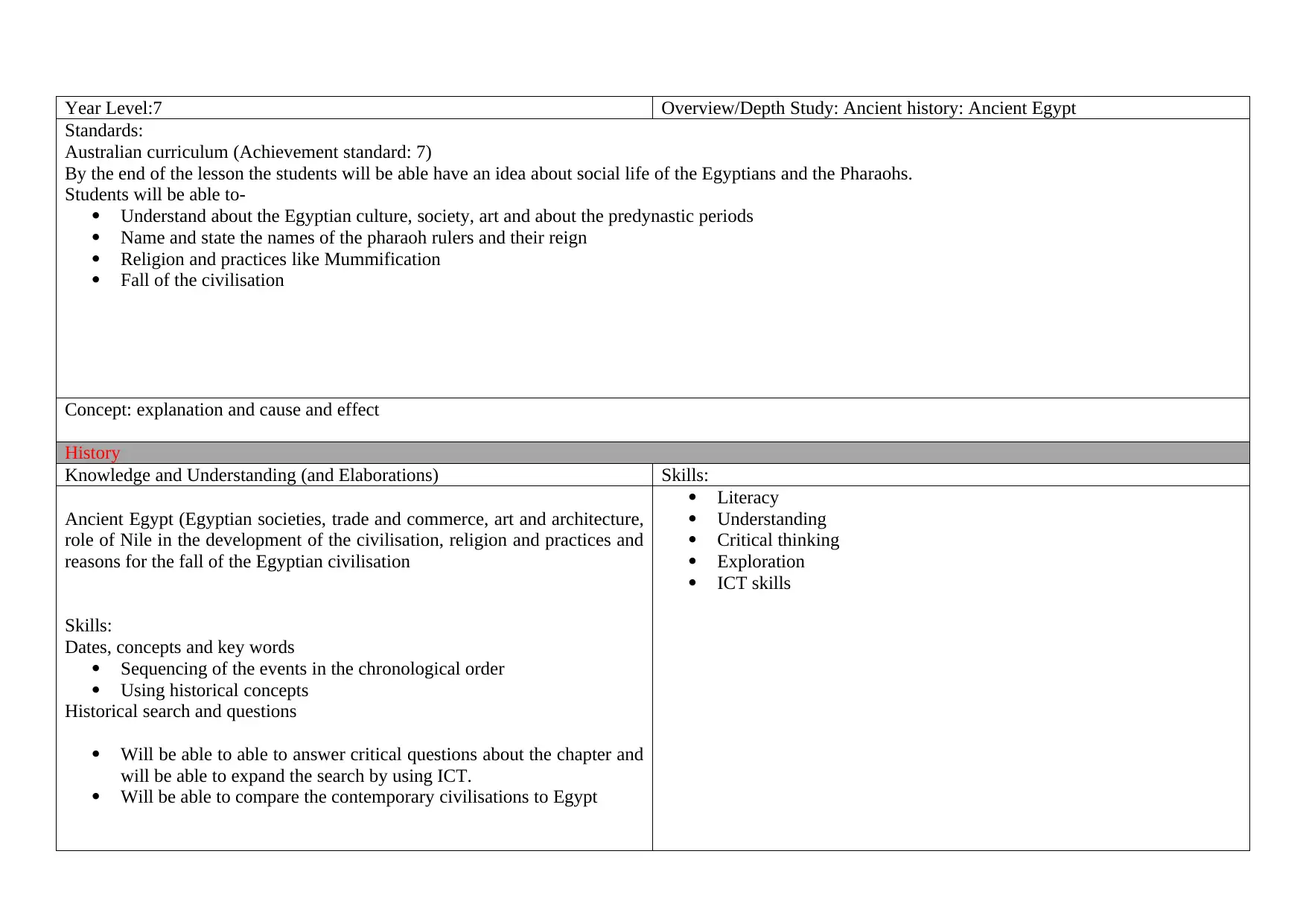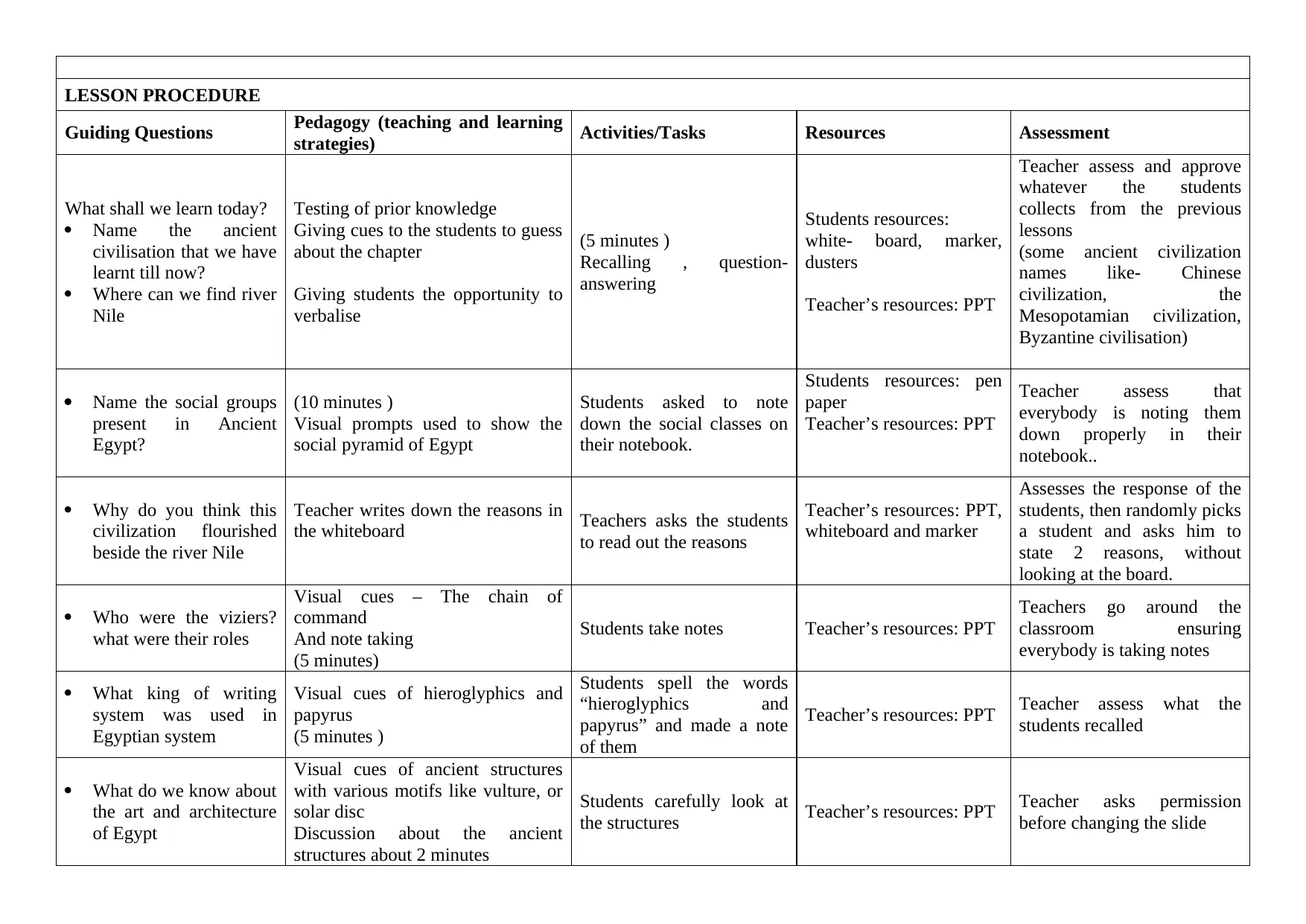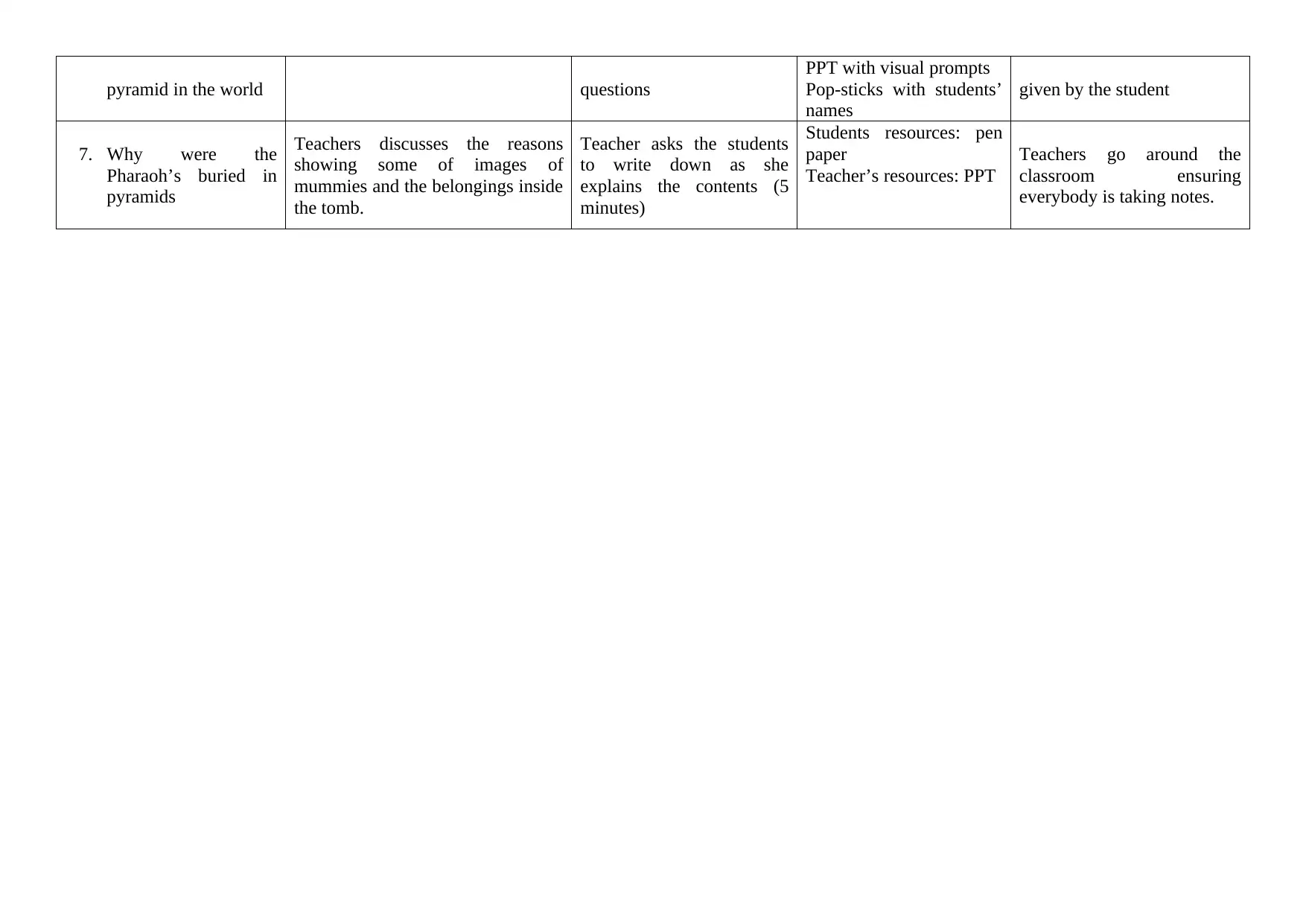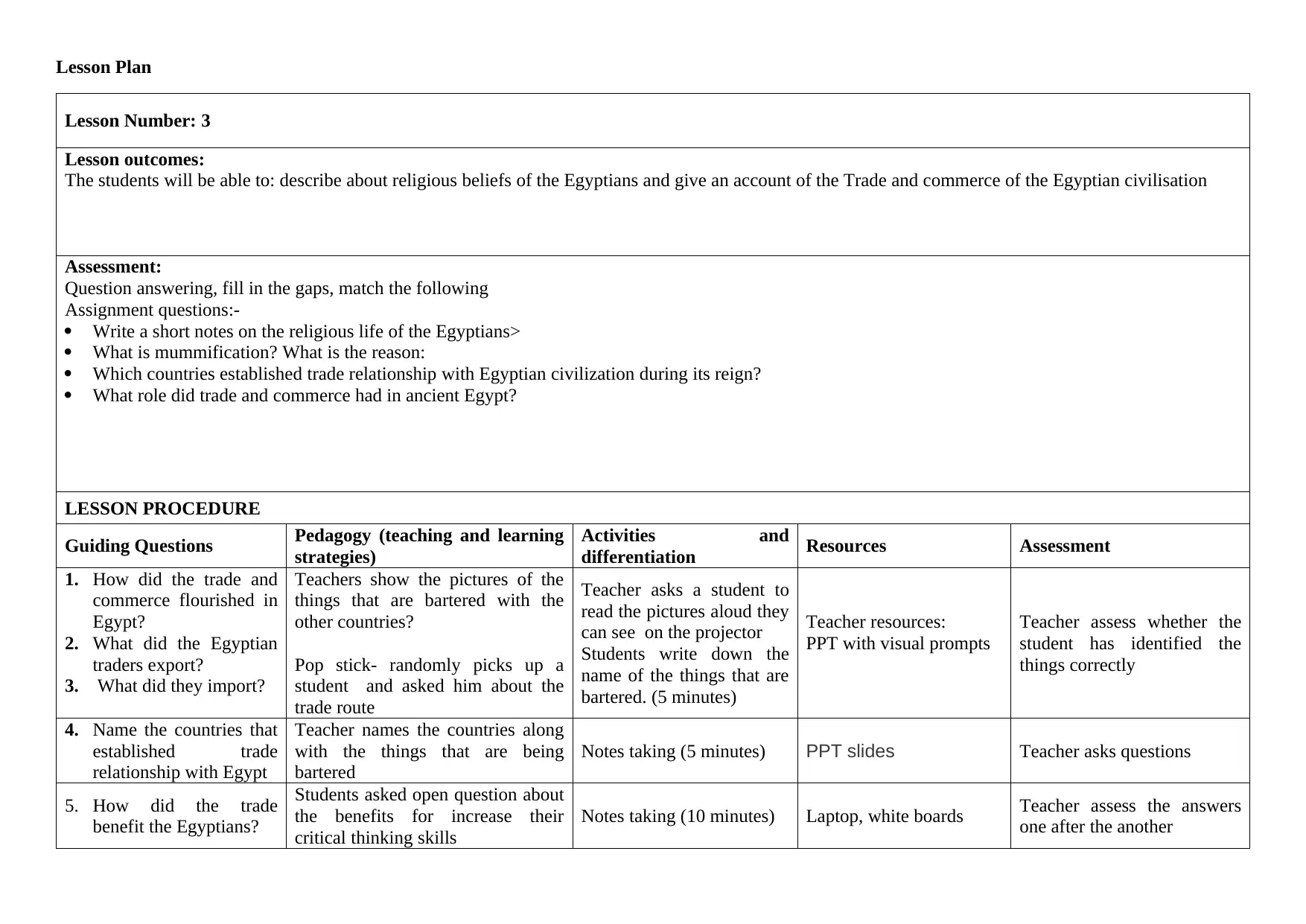Year 7 History Project: Comprehensive Lesson Plans on Ancient Egypt
VerifiedAdded on 2022/09/14
|8
|1679
|9
Project
AI Summary
This project presents a comprehensive set of three lesson plans designed for Year 7 History students, focusing on Ancient Egypt. The lesson plans cover a range of topics, including the role of the Nile River in the development of Egyptian civilization and its societal structure, the lives of pharaohs, the construction of pyramids, and the religious beliefs, trade, and commerce of the Egyptians. Each lesson includes specific learning outcomes, assessment methods, detailed procedures, guiding questions, pedagogical strategies, and resources. The plans incorporate visual aids, discussions, note-taking activities, and interactive elements. Additionally, the project requires an overview of the lesson sequence, including a critical and contextual analysis, student needs analysis and a detailed discussion. The project provides a structured and engaging approach to teaching ancient Egyptian history, encouraging students to explore various aspects of the civilization.

Year Level:7 Overview/Depth Study: Ancient history: Ancient Egypt
Standards:
Australian curriculum (Achievement standard: 7)
By the end of the lesson the students will be able have an idea about social life of the Egyptians and the Pharaohs.
Students will be able to-
Understand about the Egyptian culture, society, art and about the predynastic periods
Name and state the names of the pharaoh rulers and their reign
Religion and practices like Mummification
Fall of the civilisation
Concept: explanation and cause and effect
History
Knowledge and Understanding (and Elaborations) Skills:
Ancient Egypt (Egyptian societies, trade and commerce, art and architecture,
role of Nile in the development of the civilisation, religion and practices and
reasons for the fall of the Egyptian civilisation
Skills:
Dates, concepts and key words
Sequencing of the events in the chronological order
Using historical concepts
Historical search and questions
Will be able to able to answer critical questions about the chapter and
will be able to expand the search by using ICT.
Will be able to compare the contemporary civilisations to Egypt
Literacy
Understanding
Critical thinking
Exploration
ICT skills
Standards:
Australian curriculum (Achievement standard: 7)
By the end of the lesson the students will be able have an idea about social life of the Egyptians and the Pharaohs.
Students will be able to-
Understand about the Egyptian culture, society, art and about the predynastic periods
Name and state the names of the pharaoh rulers and their reign
Religion and practices like Mummification
Fall of the civilisation
Concept: explanation and cause and effect
History
Knowledge and Understanding (and Elaborations) Skills:
Ancient Egypt (Egyptian societies, trade and commerce, art and architecture,
role of Nile in the development of the civilisation, religion and practices and
reasons for the fall of the Egyptian civilisation
Skills:
Dates, concepts and key words
Sequencing of the events in the chronological order
Using historical concepts
Historical search and questions
Will be able to able to answer critical questions about the chapter and
will be able to expand the search by using ICT.
Will be able to compare the contemporary civilisations to Egypt
Literacy
Understanding
Critical thinking
Exploration
ICT skills
Paraphrase This Document
Need a fresh take? Get an instant paraphrase of this document with our AI Paraphraser

Rationale:
These three lesson plans have been developed in order to provide students about the ancient history of Egypt, the historical time period, to develop
knowledge about the advance level of trade and commerce, the routes of trade and commerce, the construction of the pyramids, the reign of the greatest
pharaohs in ancient Egypt.
Students should feel free to enhance their knowledge by brainstorming about the civilisation from sources other than text books.
Initially the students are provided with an overview of the dates and the location, proceeding to the societal structure of the civilisation.
Students will be made to prepare a chart of the Pharaoh’s of Egyptian civilisation along with their ruling period.
Students will be asked to find out several interesting artefacts related to Egyptian civilisation. Students will be asked to find out information about the types
of gods they worship. At the end of the assignment, the students will be asked to make a power point presentation on Egyptian civilization.
Lesson Plan
Lesson Number: 1 (40 minutes)
Lesson outcomes:
The students will be able to: describe the role of Nile in the development of Egyptian civilisation and its societal structure
Assessment: Discussions, cross-questionings, use of white boards and internets to find out extra information.
Student will complete the assignments give at the end of each of lesson sessions.
These three lesson plans have been developed in order to provide students about the ancient history of Egypt, the historical time period, to develop
knowledge about the advance level of trade and commerce, the routes of trade and commerce, the construction of the pyramids, the reign of the greatest
pharaohs in ancient Egypt.
Students should feel free to enhance their knowledge by brainstorming about the civilisation from sources other than text books.
Initially the students are provided with an overview of the dates and the location, proceeding to the societal structure of the civilisation.
Students will be made to prepare a chart of the Pharaoh’s of Egyptian civilisation along with their ruling period.
Students will be asked to find out several interesting artefacts related to Egyptian civilisation. Students will be asked to find out information about the types
of gods they worship. At the end of the assignment, the students will be asked to make a power point presentation on Egyptian civilization.
Lesson Plan
Lesson Number: 1 (40 minutes)
Lesson outcomes:
The students will be able to: describe the role of Nile in the development of Egyptian civilisation and its societal structure
Assessment: Discussions, cross-questionings, use of white boards and internets to find out extra information.
Student will complete the assignments give at the end of each of lesson sessions.

LESSON PROCEDURE
Guiding Questions Pedagogy (teaching and learning
strategies) Activities/Tasks Resources Assessment
What shall we learn today?
Name the ancient
civilisation that we have
learnt till now?
Where can we find river
Nile
Testing of prior knowledge
Giving cues to the students to guess
about the chapter
Giving students the opportunity to
verbalise
(5 minutes )
Recalling , question-
answering
Students resources:
white- board, marker,
dusters
Teacher’s resources: PPT
Teacher assess and approve
whatever the students
collects from the previous
lessons
(some ancient civilization
names like- Chinese
civilization, the
Mesopotamian civilization,
Byzantine civilisation)
Name the social groups
present in Ancient
Egypt?
(10 minutes )
Visual prompts used to show the
social pyramid of Egypt
Students asked to note
down the social classes on
their notebook.
Students resources: pen
paper
Teacher’s resources: PPT
Teacher assess that
everybody is noting them
down properly in their
notebook..
Why do you think this
civilization flourished
beside the river Nile
Teacher writes down the reasons in
the whiteboard Teachers asks the students
to read out the reasons
Teacher’s resources: PPT,
whiteboard and marker
Assesses the response of the
students, then randomly picks
a student and asks him to
state 2 reasons, without
looking at the board.
Who were the viziers?
what were their roles
Visual cues – The chain of
command
And note taking
(5 minutes)
Students take notes Teacher’s resources: PPT
Teachers go around the
classroom ensuring
everybody is taking notes
What king of writing
system was used in
Egyptian system
Visual cues of hieroglyphics and
papyrus
(5 minutes )
Students spell the words
“hieroglyphics and
papyrus” and made a note
of them
Teacher’s resources: PPT Teacher assess what the
students recalled
What do we know about
the art and architecture
of Egypt
Visual cues of ancient structures
with various motifs like vulture, or
solar disc
Discussion about the ancient
structures about 2 minutes
Students carefully look at
the structures Teacher’s resources: PPT Teacher asks permission
before changing the slide
Guiding Questions Pedagogy (teaching and learning
strategies) Activities/Tasks Resources Assessment
What shall we learn today?
Name the ancient
civilisation that we have
learnt till now?
Where can we find river
Nile
Testing of prior knowledge
Giving cues to the students to guess
about the chapter
Giving students the opportunity to
verbalise
(5 minutes )
Recalling , question-
answering
Students resources:
white- board, marker,
dusters
Teacher’s resources: PPT
Teacher assess and approve
whatever the students
collects from the previous
lessons
(some ancient civilization
names like- Chinese
civilization, the
Mesopotamian civilization,
Byzantine civilisation)
Name the social groups
present in Ancient
Egypt?
(10 minutes )
Visual prompts used to show the
social pyramid of Egypt
Students asked to note
down the social classes on
their notebook.
Students resources: pen
paper
Teacher’s resources: PPT
Teacher assess that
everybody is noting them
down properly in their
notebook..
Why do you think this
civilization flourished
beside the river Nile
Teacher writes down the reasons in
the whiteboard Teachers asks the students
to read out the reasons
Teacher’s resources: PPT,
whiteboard and marker
Assesses the response of the
students, then randomly picks
a student and asks him to
state 2 reasons, without
looking at the board.
Who were the viziers?
what were their roles
Visual cues – The chain of
command
And note taking
(5 minutes)
Students take notes Teacher’s resources: PPT
Teachers go around the
classroom ensuring
everybody is taking notes
What king of writing
system was used in
Egyptian system
Visual cues of hieroglyphics and
papyrus
(5 minutes )
Students spell the words
“hieroglyphics and
papyrus” and made a note
of them
Teacher’s resources: PPT Teacher assess what the
students recalled
What do we know about
the art and architecture
of Egypt
Visual cues of ancient structures
with various motifs like vulture, or
solar disc
Discussion about the ancient
structures about 2 minutes
Students carefully look at
the structures Teacher’s resources: PPT Teacher asks permission
before changing the slide
⊘ This is a preview!⊘
Do you want full access?
Subscribe today to unlock all pages.

Trusted by 1+ million students worldwide

Who was greatest
Pharaoh of the Egyptian
civilization
Visual cue shows the picture of
Ramses II (67 years reign)
Discussion about his reign
(10 minutes)
Students jot down the
important points about the
reign of the Egyptian
Pharaohs
Students resources: pen
paper
Teacher’s resources: PPT
Pop sticks – with names
of student
Teacher randomly select a
student an ask him about the
greatest King of Egypt
Pharaoh of the Egyptian
civilization
Visual cue shows the picture of
Ramses II (67 years reign)
Discussion about his reign
(10 minutes)
Students jot down the
important points about the
reign of the Egyptian
Pharaohs
Students resources: pen
paper
Teacher’s resources: PPT
Pop sticks – with names
of student
Teacher randomly select a
student an ask him about the
greatest King of Egypt
Paraphrase This Document
Need a fresh take? Get an instant paraphrase of this document with our AI Paraphraser

Lesson Plan
Lesson Number: 2
Lesson outcomes:
The students will be able to: Egyptian Kings and Pyramids
1. What kind of a life did Pharaohs used to live?
2. What was their role in the administration of Egypt?
3. What was the belief behind the construction of the pyramids?
Assessment:
Students will be able to name the Egyptian pharaohs chronologically
Students will be able to describe the reasons for the construction of the pyramids , the name of the greatest pyramid
LESSON PROCEDURE
Guiding Questions Pedagogy (teaching and learning
strategies) Activities/Tasks Resources Assessment
1. What are Egyptian
Kings called?
2. Who was the greatest
Egyptian King?
Teacher asks the guiding questions
Teacher shows the picture of a
pharaoh
Students answer loudly
(5 minutes) Nil Teachers assess what the
students recall- Pharaoh
3. Who was the youngest
pharaoh who died at
the age of 15?
4. Who discovered the
tomb of King Tut?
Teacher display the picture of
Tutankhamen
Describes about the reign of the
pharaohs
Howard Carter
Students and note down the
points stated by the teacher.
(5 minutes)
Teacher’s resources: PPT
Students are assessed on their
level of engagement by
teacher randomly selecting
students to respond to
questions
5. Why are pyramids
built?
Visuals of a pyramid shown and
reasons for their building was
described to the children
Notes taking
(5 minutes)
Students resources: pen
paper
Teacher’s resources: PPT
Teachers provide 5 sets of fill
in the blanks for the children
to solve
6. Name the greatest Pop-stick (random selection) Teacher asks random Teacher resources: Teacher assess by the answer
Lesson Number: 2
Lesson outcomes:
The students will be able to: Egyptian Kings and Pyramids
1. What kind of a life did Pharaohs used to live?
2. What was their role in the administration of Egypt?
3. What was the belief behind the construction of the pyramids?
Assessment:
Students will be able to name the Egyptian pharaohs chronologically
Students will be able to describe the reasons for the construction of the pyramids , the name of the greatest pyramid
LESSON PROCEDURE
Guiding Questions Pedagogy (teaching and learning
strategies) Activities/Tasks Resources Assessment
1. What are Egyptian
Kings called?
2. Who was the greatest
Egyptian King?
Teacher asks the guiding questions
Teacher shows the picture of a
pharaoh
Students answer loudly
(5 minutes) Nil Teachers assess what the
students recall- Pharaoh
3. Who was the youngest
pharaoh who died at
the age of 15?
4. Who discovered the
tomb of King Tut?
Teacher display the picture of
Tutankhamen
Describes about the reign of the
pharaohs
Howard Carter
Students and note down the
points stated by the teacher.
(5 minutes)
Teacher’s resources: PPT
Students are assessed on their
level of engagement by
teacher randomly selecting
students to respond to
questions
5. Why are pyramids
built?
Visuals of a pyramid shown and
reasons for their building was
described to the children
Notes taking
(5 minutes)
Students resources: pen
paper
Teacher’s resources: PPT
Teachers provide 5 sets of fill
in the blanks for the children
to solve
6. Name the greatest Pop-stick (random selection) Teacher asks random Teacher resources: Teacher assess by the answer

pyramid in the world questions
PPT with visual prompts
Pop-sticks with students’
names
given by the student
7. Why were the
Pharaoh’s buried in
pyramids
Teachers discusses the reasons
showing some of images of
mummies and the belongings inside
the tomb.
Teacher asks the students
to write down as she
explains the contents (5
minutes)
Students resources: pen
paper
Teacher’s resources: PPT
Teachers go around the
classroom ensuring
everybody is taking notes.
PPT with visual prompts
Pop-sticks with students’
names
given by the student
7. Why were the
Pharaoh’s buried in
pyramids
Teachers discusses the reasons
showing some of images of
mummies and the belongings inside
the tomb.
Teacher asks the students
to write down as she
explains the contents (5
minutes)
Students resources: pen
paper
Teacher’s resources: PPT
Teachers go around the
classroom ensuring
everybody is taking notes.
⊘ This is a preview!⊘
Do you want full access?
Subscribe today to unlock all pages.

Trusted by 1+ million students worldwide

Lesson Plan
Lesson Number: 3
Lesson outcomes:
The students will be able to: describe about religious beliefs of the Egyptians and give an account of the Trade and commerce of the Egyptian civilisation
Assessment:
Question answering, fill in the gaps, match the following
Assignment questions:-
Write a short notes on the religious life of the Egyptians>
What is mummification? What is the reason:
Which countries established trade relationship with Egyptian civilization during its reign?
What role did trade and commerce had in ancient Egypt?
LESSON PROCEDURE
Guiding Questions Pedagogy (teaching and learning
strategies)
Activities and
differentiation Resources Assessment
1. How did the trade and
commerce flourished in
Egypt?
2. What did the Egyptian
traders export?
3. What did they import?
Teachers show the pictures of the
things that are bartered with the
other countries?
Pop stick- randomly picks up a
student and asked him about the
trade route
Teacher asks a student to
read the pictures aloud they
can see on the projector
Students write down the
name of the things that are
bartered. (5 minutes)
Teacher resources:
PPT with visual prompts
Teacher assess whether the
student has identified the
things correctly
4. Name the countries that
established trade
relationship with Egypt
Teacher names the countries along
with the things that are being
bartered
Notes taking (5 minutes) PPT slides Teacher asks questions
5. How did the trade
benefit the Egyptians?
Students asked open question about
the benefits for increase their
critical thinking skills
Notes taking (10 minutes) Laptop, white boards Teacher assess the answers
one after the another
Lesson Number: 3
Lesson outcomes:
The students will be able to: describe about religious beliefs of the Egyptians and give an account of the Trade and commerce of the Egyptian civilisation
Assessment:
Question answering, fill in the gaps, match the following
Assignment questions:-
Write a short notes on the religious life of the Egyptians>
What is mummification? What is the reason:
Which countries established trade relationship with Egyptian civilization during its reign?
What role did trade and commerce had in ancient Egypt?
LESSON PROCEDURE
Guiding Questions Pedagogy (teaching and learning
strategies)
Activities and
differentiation Resources Assessment
1. How did the trade and
commerce flourished in
Egypt?
2. What did the Egyptian
traders export?
3. What did they import?
Teachers show the pictures of the
things that are bartered with the
other countries?
Pop stick- randomly picks up a
student and asked him about the
trade route
Teacher asks a student to
read the pictures aloud they
can see on the projector
Students write down the
name of the things that are
bartered. (5 minutes)
Teacher resources:
PPT with visual prompts
Teacher assess whether the
student has identified the
things correctly
4. Name the countries that
established trade
relationship with Egypt
Teacher names the countries along
with the things that are being
bartered
Notes taking (5 minutes) PPT slides Teacher asks questions
5. How did the trade
benefit the Egyptians?
Students asked open question about
the benefits for increase their
critical thinking skills
Notes taking (10 minutes) Laptop, white boards Teacher assess the answers
one after the another
Paraphrase This Document
Need a fresh take? Get an instant paraphrase of this document with our AI Paraphraser

6. What is mummification?
Shows the image of Tutankhamen’s
mummy.
List down the procedures of
mummification by showing picture
cues
Students provided time for
notes taking
(5 minutes)
PPT slides Teacher assess what the
students recall.
7. Apart from
mummification, what
else do you know about
the religion of the
Egyptians?
Images of Ra, Geb and Nur, Isis,
Nepthys are shows .(5 minutes)
Student write down the
names of the gods and their
role
PPT slides
Teacher asks question, as
soon as the students stopped
writing.
Assessment :
Teachers provided guideline
questions, match the following and
fill in the blanks.
Question answering sessions (10
minutes )
Students raise their hands
one at a time to answer the
questions.
Shows the image of Tutankhamen’s
mummy.
List down the procedures of
mummification by showing picture
cues
Students provided time for
notes taking
(5 minutes)
PPT slides Teacher assess what the
students recall.
7. Apart from
mummification, what
else do you know about
the religion of the
Egyptians?
Images of Ra, Geb and Nur, Isis,
Nepthys are shows .(5 minutes)
Student write down the
names of the gods and their
role
PPT slides
Teacher asks question, as
soon as the students stopped
writing.
Assessment :
Teachers provided guideline
questions, match the following and
fill in the blanks.
Question answering sessions (10
minutes )
Students raise their hands
one at a time to answer the
questions.
1 out of 8
Your All-in-One AI-Powered Toolkit for Academic Success.
+13062052269
info@desklib.com
Available 24*7 on WhatsApp / Email
![[object Object]](/_next/static/media/star-bottom.7253800d.svg)
Unlock your academic potential
Copyright © 2020–2025 A2Z Services. All Rights Reserved. Developed and managed by ZUCOL.


